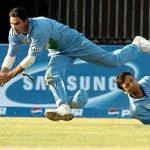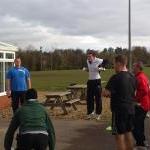Posts Tagged ‘cricket’
How to get more agile and low to the ground for cricket fielding
Become more agile in 5 days.
 When fielding in cricket, you are putting your body under a lot of stress and strain due to the stretching/reaching and diving to catch the ball.
When fielding in cricket, you are putting your body under a lot of stress and strain due to the stretching/reaching and diving to catch the ball.
If the underlying strength and mobility behind these movements isn’t poor then an injury is more likely.
To do these movements successfully you will need to have good hip and knee control, and good flexibility too.
Read MoreCricket Fitness
Cricketers need to be fit to play.
On initial appearance cricket may not appear to be the most physical of sports. Brief periods of activity are followed by longer periods of rest. Apart from fast bowlers who can perform long series of overs, the rest of the team do not look to be that active.
However, this is a mistaken concept as it is precisely this intermittent high intensity activity that requires the Cricketer to be very fit. The movements are fast and dynamic and have to be sustained throughout a morning or afternoon in the field.
Read MoreHow to practice: should we teach this first?
“Rather than teach what to practice, I should start with how to practice”
 This was the lesson I learnt from working with golf coach John Jacobs on a recent training day.
This was the lesson I learnt from working with golf coach John Jacobs on a recent training day.
John had set up a simple pitching task for the 10 golfers: they had to try and pitch 10 balls into some different spaces he had marked out with cones.
Read MoreCoaching community of practice
“Learning is a social phenomenon”
 Ever been on a course or workshop and struggled to implement the ideas you have learnt back at you club, team or school?
Ever been on a course or workshop and struggled to implement the ideas you have learnt back at you club, team or school?
Ever been on a course, thought I would like to know more, but the thought of going on a 3-4 day course is too daunting/ expensive?
Read More6 ways to get better as a strength and conditioning coach.
 I am pleased to announce that on Saturday 6 people passed the level 1 Strength and Conditioning for Sport Course, and 2 passed the level 2.
I am pleased to announce that on Saturday 6 people passed the level 1 Strength and Conditioning for Sport Course, and 2 passed the level 2.
There were some excellent examples of coaching practice on the day, using skills and knowledge gained from the previous workshops, their studies and their own experiences.
Read MoreCoaching Legends: Learning from the best.
Standing on the shoulders of giants.
I spent Monday in the presence of some Coaching giants: Frank Dick, Bill Sweetenham and Vern Gambetta at the Global Coaches House.
Continual Professional Development in the Digital Age
How Technology Aids Learning
Sharing of information has come a long way in the last decade. A quick search on the internet can reveal text, photos and videos on virtually any topic. The quality may vary, but whether we like it or not the information is out there.
In fact, it now seems ridiculous that when I was an undergraduate in the 1990s, I used to get the tube around London to visit varying medical libraries to photocopy articles to read as part of my studies. It would often take a whole day to collect the information I was looking for.
Read More
